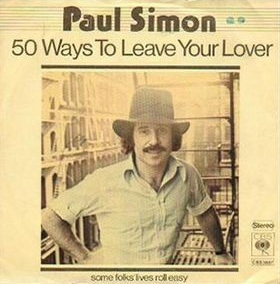 | 50 Ways to Leave Your LoverPaul Simon |
Writer(s): Paul Simon (see lyrics here) Released: January 2, 1976 First Charted: December 12, 1975 Peak: 13 US, 13 CB, 12 GR, 11 HR, 14 RR, 12 AC, 1 CL, 23 UK, 1 CN, 35 AU, 1 DF (Click for codes to charts.) Sales (in millions): 1.0 US, 0.2 UK Airplay/Streaming (in millions): 2.0 radio, 19.65 video, 193.83 streaming |
Awards:Click on award for more details. |
About the Song:Paul Simon and Art Garfunkel recorded as a duo from 1964 to 1970, finding themselves at the forefront of the folk-rock movement. They “were more playful than they get credit for being, but for a lot of self-impressed ’60s kids…they were poets, and that was a big part of the appeal.” SG When Simon launched his solo career, he “became a kid in a candy store. He tinkered with reggae, with gospel, with Peruvian folk music. He set these bold, vivid, joyous sounds to breezy, nostaliga-drenched lyrics, clearly taking nothing too seriously.” SG He started writing “50 Ways to Leave Your Lover” “as a sort of kids’ game” SG in response to his failed marriage. His three-year-old son Harper was at his apartment and Simon was teaching him rhyming, coming up with lines like “You just slip out the back, Jack” and “Make a new plan, Stan.” As author Dave Thompson said, “Think of a name and Simon will come up with a ruse ro rhyme with it.” DT It might be the single silliest divorce song ever put on record.” SG Simon himself called it “a nonsense song” SG but it is “actually a dazzling little piece of storytelling.” SG “Simon presents the whole thing as a dialog, almost a scene from a movie.” SG It “isn’t mired in reflection or self-pity. Instead, it’s a sly exultation, a wink at the whole idea that there can be freedom after marriage.” SG Musically, the song “is a casually funky track, one that keeps bubbling throughout. The chorus doesn’t explode; it effortlessly slides right in.” SG It also features backup vocals from Patti Austin, Valerie Simpson, and Phoebe Snow – all “prominent musicians in their own right.” SG Resources:
Related Links:First posted 10/11/2023. |








No comments:
Post a Comment